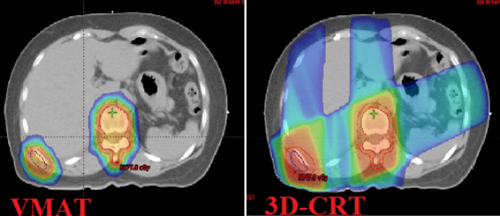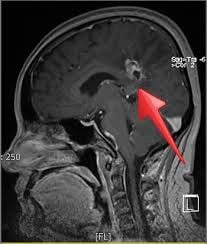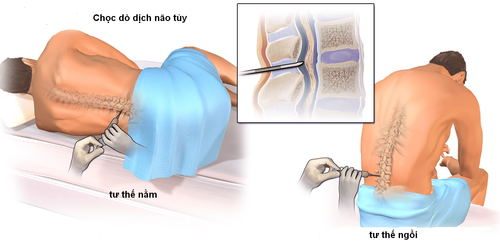This is an automatically translated article.
The article was written by MSc Nguyen Manh Ha - Head of the Department of Radiation Therapy, Technician Nguyen Van Han and Technician Nguyen Van Nam - Radiation Therapy Center - Vinmec Times City International Hospital.Cancers that start in one part of the body can spread to other parts of the body. If a tumor has spread to the bone, this new cancer site is called a bone metastasis. In most cases, bone metastases are the result of the original spread of cancer cells to the bone. For example, a person with breast cancer will often metastasize to the bone.
All cancers can metastasize to bone including breast, kidney, lung, prostate and thyroid cancers. Multiple myeloma, a disease characterized by uncontrolled proliferation of white blood cells called plasma cells, can also damage bone.
Cancer treatments have made many advances in recent years, helping more patients live longer with cancer than ever before. however, bone metastases can still occur months or even years after the initial cancer diagnosis. There are a variety of appropriate treatment options for patients with bone metastases for palliative prophylaxis (primarily pain) and to prevent local complications (fractures, spinal cord compression, etc.).
1. Symptoms and signs of bone metastases
Pain is the most common symptom of bone metastases. Pain from bone metastases may be worse with movement during normal daily activities, but can sometimes be worse at night or at rest.
Bone metastases can weaken bones, putting bones at risk of fracture. In some cases, a fracture is the first sign of bone metastasis. The bones of the arms and legs, as well as the bones of the spine, are the most commonly injured or broken bones.
If the cancer spreads to the bones of the spine, it can push into the spinal cord and cause spinal cord compression. Signs of spinal cord compression include back pain, numbness or weakness in the body or limbs, difficulty urinating.... If any of these symptoms increase, you should tell your partner's oncologist. condition and get treatment right away.
Bone metastases can cause calcium to be released from the bones into the bloodstream. Increased calcium can cause loss of appetite, nausea, thirst, constipation, fatigue. If you notice these symptoms, you should talk to your doctor right away.

Bệnh nhân di căn xương thường xuyên cảm thấy buồn nôn
In some cases, you have no noticeable symptoms or signs that the cancer has spread to the bone. Better yet, you can have regular check-ups and the risk of cancer metastasis will be detected during the examination or CT, MRI.
2. Treatment of metastatic bone cancer
The goal of treatment for bone metastases is to control pain and other symptoms to improve your quality of life. In some cases, these treatments can also help you live longer and improve your quality of life and prevent complications.
Your doctor will be able to prescribe you a medicine called a drug that inhibits bone fractures or slows bone loss caused by metastases and reduces the risk of fractures and reduces pain.
Your doctor may also prescribe medication for chemotherapy or hormonal therapy . These are a number of different drugs that help kill cancer cells or stop cancer cells from growing. These types of treatment may be prescribed when you are diagnosed with cancer and if the cancer has spread to another part of the body. Your oncologist will inform you about the types of treatments.
Treatment for bone metastases will not cure your cancer. However, modern treatments allow doctors to control bone metastases well, allowing many patients to improve their quality of life and live longer.

Điều trị ung thư di căn xương nhằm kiểm soát đau cho người bệnh
3. Radiotherapy for metastatic bone cancer
Radiation therapy is a method of using high-energy X-rays to kill cancer cells. This treatment is decided by a radiation oncologist. Radiation therapy is a very common treatment for cancer that has spread to the bones.
In general, radiation therapy is very effective in treating metastatic cancer and in good control of the symptoms caused when the cancer has spread to the bones. Radiation therapy can ease symptoms and pain caused by bone metastases during treatment, but it also has side effects a few weeks after you finish the radiation.
Radiation therapy uses a beam of radiation that comes from outside the body and is targeted at the location of the tumor that has been planned by the doctor. In some cases, the doctor will use radioactive material to put into the blood vessels, this is called radiopharmaceutical and it will kill cancer cells in all bones by traveling through the blood stream. and to cancer cells inside the bone.

Hình 1: Quy trình điều trị xạ trị hàng ngày đối với xạ trị di căn xương.
4. The role of surgery and interventional procedures for bone metastasis
In the case of tumor causing extravertebral rupture the doctor may recommend surgery before starting irradiation. This procedure is usually performed by a spine or chiropractor. If surgery has already been done, radiation therapy usually begins a few weeks after surgery.
For tumors that do not rupture the vertebral body or cause vertebral body collapse the doctor may recommend seeing a specialist (interventional radiologist or spine surgeon) who can pump a type of bone cement to stabilize bones, and relieve pain.
5. How is radiation treatment for cancer?
Radiation therapy is a process that damages genes or important components of cancer cells, limiting the ability of cancer cells to proliferate. Radiation therapy can also block blood supply to tumors or kill cancer cells.
After radiation treatment is over, your body may still experience some side effects from radiation damage during radiation therapy and it is usually several weeks before the radiation reaches its full effect. Normal cells are also affected by radiation, but healthy cells are better able to repair radiation damage on their own than cancer cells.

Hình 2: Bộ dụng cụ cố định trong xạ trị ung thư di căn xương
Radiation therapy is a non-invasive and painless treatment, just like an X-ray. You will be able to go home after treatment. There are many radiotherapy techniques that can be used in the treatment of bone metastases: 3D-CRT (routine radiotherapy), VMAT, SBRT, SRS ... depending on the location, size, and complexity of the metastatic lesion. bone base.

Hình 3: Đặt tư thế và cố định người bệnh xạ trị ung thư di căn xương
Bone cancer treatment is usually prescribed daily, from Monday to Friday, for about one to three weeks depending on the doctor's decision to achieve the best effect.
Sometimes the treatment is done by radiosurgery (SRS, SBRT) which is radiotherapy using high dose fractions and short treatment time (usually 1 to 5 days).

Hình 4. So sánh kỹ thuật xạ trị VMAT và 3D-CRT cho di căn xương, VMAT giúp bảo vệ các cơ quan xung quanh tốt hơn rõ rệt so với 3D-CRT.
6. Radiotherapy side effects
Fatigue is the most common side effect you may experience during radiation therapy. Fatigue usually begins in the middle of the week of treatment and may persist for several weeks after treatment. Radiation therapy can cause hair loss and hair will be able to grow back to normal after radiation therapy. You may also notice some minor skin changes or a rough feeling in the skin where the radiation was irradiated. This should go away with time. Side effects are different for everyone and depend on the treatment area on your body. Your radiation oncologist and nurse will monitor you closely during your treatment and evaluate your symptoms. Certain medications may be prescribed to make you more comfortable during treatment.
Vinmec International General Hospital is one of the hospitals that not only ensures professional quality with a team of leading medical professionals, modern equipment and technology, but also stands out for its examination and consultation services. comprehensive and professional medical consultation and treatment; civilized, polite, safe and sterile medical examination and treatment space. Customers when choosing to perform tests here can be completely assured of the accuracy of test results.
Please dial HOTLINE for more information or register for an appointment HERE. Download MyVinmec app to make appointments faster and to manage your bookings easily.













